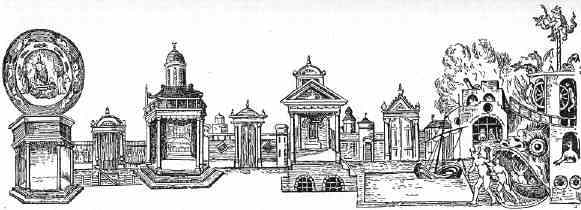The mystery plays
Folk drama--mummers' plays, jugglers, ballad singers--had always flourished in the festivals and fairs of country and city. They were part of a rich pre-literate oral culture. The earliest formal (written) plays performed in England were dramatizations of Biblical stories. They ranged from the Quem Quaeritis, the short musical performance at the tomb of the risen Christ, to extensive and sophisticated short dramas about the nativity, the crucifixion, and the Day of Judgement.
These "mystery" plays, as they came to be called, were performed on platforms or carts that moved around the city to various stations where the audience gathered.
The biblical scenes that made up the mystery play were staged by the various guilds. At York, for instance, the play of Noah was put on by the carpenter's guild, no doubt because they were able to build the ark most effectively.
The scene here is of a continental mystery play, with different "houses" where the action could take place; click for an example recorded in Shakespeare's time.
Why start with a mystery?
This section on the stage and staging of Shakespeare's plays begins with the Mystery plays rather than the earlier drama of Greece and Rome because, although Shakespeare certainly knew the plays of Plautus and Seneca, there is no evidence that the Elizabethan stage was influenced by the stages of classical antiquity.
